What Type of Knife to Cut Raw Chicken Breast: Expert Tips
Using the right knife is key when cut raw chicken breast. It makes the job easier, faster, and safer. However, using the wrong knife can cause several problems.
A dull or improper knife can make uneven cuts, making it harder to cook the chicken well. It can also be dangerous. You may have to press harder to cut through the meat, which could lead to slips and cuts. Plus, using a lousy knife can harm food safety. A blunt knife may tear the chicken, exposing it to bacteria.
This article will show you the best knives for cutting raw chicken breasts. It will also give tips on cutting the chicken correctly, caring for your knife, and keeping your kitchen safe. You will be ready to cut chicken like a pro by the end! Let’s get started.
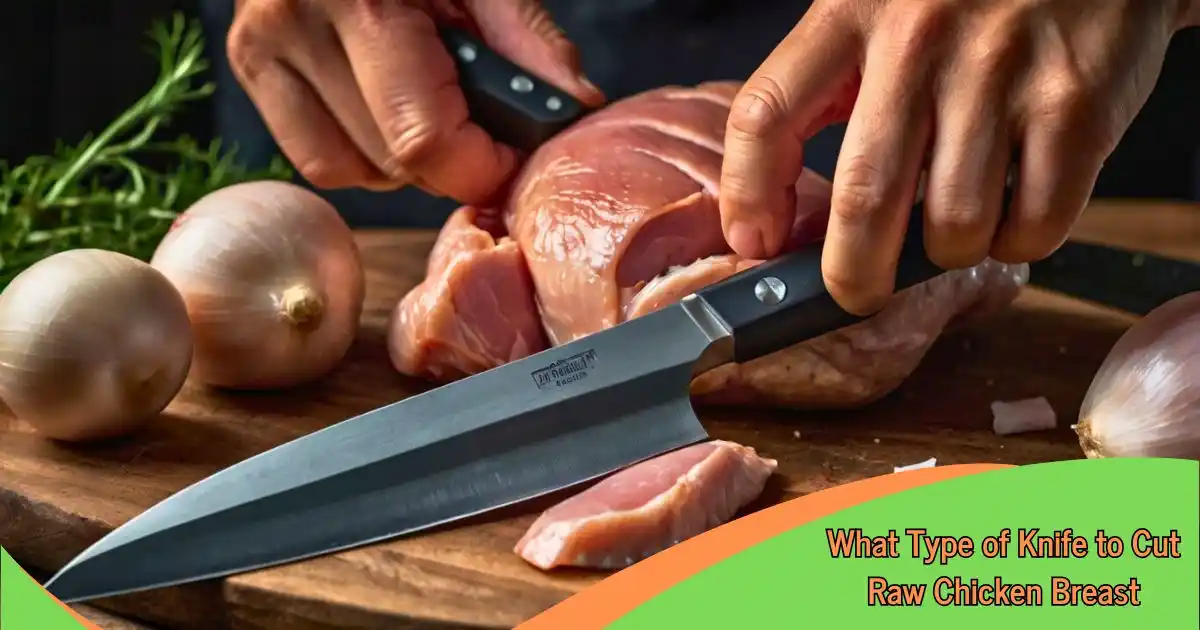
Key Features to Look for in a Knife for Cut Raw Chicken Breast
Choosing the right knife makes cutting raw chicken breasts easy and safe. Let’s look at what matters most when picking one.
1. Blade Material
The material of the blade is essential. Here are two great options:
- Stainless Steel: It won’t rust and is easy to clean. It’s great for everyday use.
- Carbon Steel stays sharp for a long time, but it needs to be taken care of to prevent rust.
2. Blade Flexibility
Do you need a flexible blade or a stiff one?
- Flexible Blades: Perfect for precise cuts, like filleting.
- Stiff Blades: Good for straight cuts, like portioning chicken.
3. Blade Length and Shape
The size and shape of the blade also matter.
- Length: The best blade is 6 to 8 inches long. It’s easy to control and can handle most tasks.
- Shape: A curved edge helps you slice smoothly. A pointed tip works well for detailed cutting.
4. Handle Design
The handle is key for comfort and safety.
- Ergonomics: Pick a handle that feels good in your hand and doesn’t slip.
- Material: Handles come in wood, plastic, or composite. Choose one that fits your grip and is easy to clean.
5. Hygiene and Maintenance
Keeping your knife clean is essential for safety.
- Seamless Construction: Gaps between the blade and handle can trap food. A seamless knife is more hygienic.
- Ease of Cleaning: Many knives are dishwasher-safe, but hand washing keeps them sharp longer.
Best Types of Knives for Cutting Raw Chicken Breast
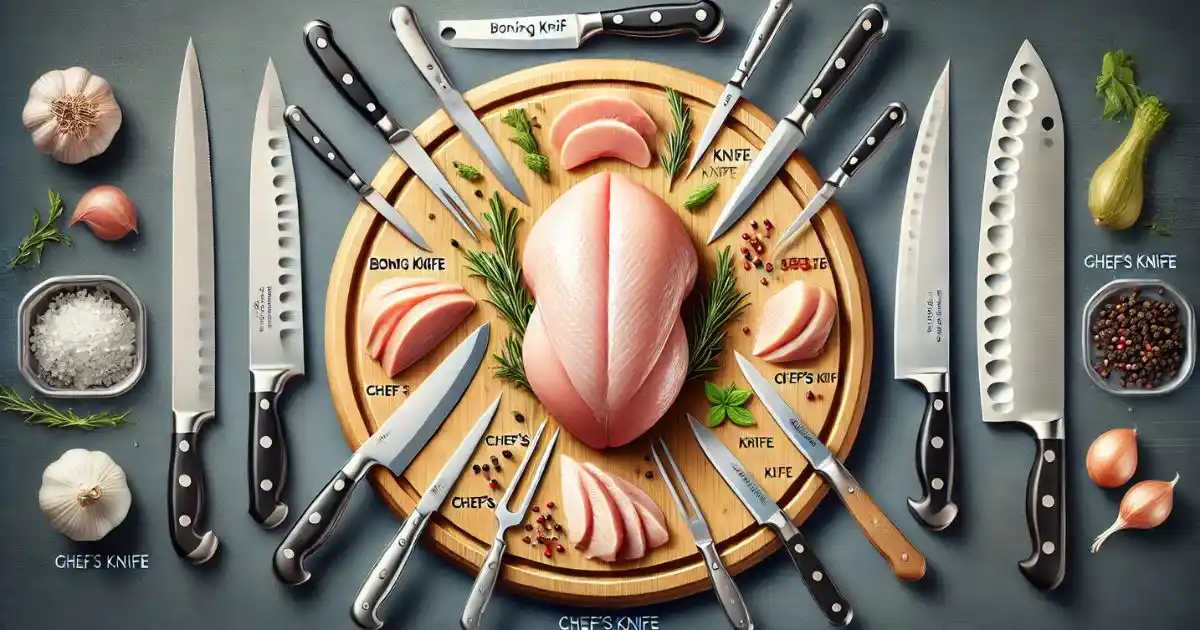
Choosing the right knife for cutting raw chicken breast can make cooking easier and more enjoyable. Let’s explore some top choices:
1. Chef’s Knife
A chef’s knife is a versatile tool in the kitchen. Its broad and sharp blade handles various tasks, including slicing raw chicken breast. Its weight and balance allow for smooth, even cuts. For instance, the Victorinox Swiss Army Fibrox Pro Chef’s Knife is praised for its durability and comfort.
2. Boning Knife
A boning knife, designed to remove bones, has a thin, flexible blade. This flexibility makes it perfect for cutting around bones and joints, especially useful when preparing raw chicken breast. The Victorinox Fibrox Pro 6-inch Boning Knife is noted for its ease of use and grippy handle.
3. Honesuki (Japanese Poultry Knife)
The honesuki is a Japanese knife made explicitly for breaking down poultry. Its small, triangular blade is rigid and heavy for its size, providing precision and control. The Tojiro 6-inch Honesuki Boning Knife is a recommended choice for this purpose.
4. Paring Knife
While typically used for smaller tasks, a sharp paring knife can be practical for detailed work on raw chicken breast, such as trimming fat or removing tendons. It’s easy to handle and maneuver around small areas.
Comparison Table
Knife Type | Blade Length | Flexibility | Best For |
Chef’s Knife | 8 inches | Moderate | General slicing and chopping tasks |
Boning Knife | 6 inches | High | Removing bones and precise cuts |
Honesuki | 6 inches | Low | Breaking down poultry |
Paring Knife | 3-4 inches | Moderate | Trimming and detailed work |
Choosing the right knife depends on your specific needs and comfort. A chef’s knife offers versatility, while a boning knife provides precision. The hone suki specializes in poultry, and a paring knife is great for small tasks. Consider what feels best in your hand and suits your cooking style.
How to Cut Raw Chicken Breast: A Step-by-Step Guide

Cutting raw chicken breast properly is essential for cooking. It ensures even cooking and enhances the taste of your dishes. Here’s how to do it:
1. Gather Your Tools
- Knife: Use a sharp chef’s knife or boning knife. A sharp blade makes cutting easier and safer.
- Cutting Board: Choose a sturdy, non-slip cutting board. This will prevent the chicken from slipping while you cut it.
- Gloves (Optional): Wearing gloves can help maintain hygiene.
2. Prepare the Chicken
- Thawing: If the chicken is frozen, thaw it in the refrigerator overnight. Avoid thawing at room temperature to prevent bacterial growth.
- Rinsing: Some prefer to rinse the chicken under cold water. However, this can spread bacteria. It’s safer to pat the chicken dry with paper towels.
3. Position the Chicken
- Flat Surface: Place the chicken breast flat on the cutting board.
- Orientation: If you’re right-handed, position the thickest part of the chicken breast on the right side. For left-handed individuals, place the thickest part on the left.
4. Slice the Chicken
- Butterflying: To create thinner pieces, you can butterfly the chicken. Hold the chicken steady with one hand. On the other hand, carefully slice horizontally into the thickest part of the breast, stopping just before cutting through. Open it like a book. This method helps the chicken cook faster and more evenly.
- Cutting into Pieces: Slice the butterflied chicken into cubes or strips of the desired size. Ensure all pieces are similar in size for even cooking.
5. Clean Up
- Sanitize: After cutting, wash your hands, knife, and cutting board with hot, soapy water to prevent cross-contamination.
- Storage: If the cut chicken is not to be cooked immediately, store it in an airtight container in the refrigerator. Use it within 1-2 days.
Tips for Success
- Sharp Knife: A sharp knife reduces the risk of accidents and makes cutting easier.
- Even Pieces: Cutting the chicken into uniform pieces ensures they cook at the same rate.
- Practice: If you’re new to cutting chicken, practice with a small piece to build confidence.
Knife Maintenance and Care for Cutting Raw Chicken Breast
Proper knife maintenance is essential for safe and efficient food preparation. A well-maintained knife ensures clean cuts, reduces the risk of accidents, and prolongs the lifespan of your blade. Here’s how to care for your knife when cutting raw chicken breast:
1. Regular Cleaning
- Hand Wash Only: Always wash your knife by hand using warm, soapy water. Avoid placing it in the dishwasher, as the high heat and detergents can damage the blade and handle.
- Immediate Drying: Dry the knife immediately with a clean cloth to prevent rusting. Leaving it wet can lead to corrosion over time.
2. Proper Storage
- Knife Blocks or Magnetic Strips: Store your knives in a knife block or on a magnetic strip. This keeps the blade protected and easily accessible. Avoid storing knives loosely in drawers, as this can cause damage to the blade and increase the risk of injury.
- Avoid Wooden Cutting Boards: While wooden cutting boards are traditional, they can dull knives faster. Professional chefs suggest using synthetic rubber cutting boards instead. These boards are gentler on knife blades, helping them maintain sharpness and efficiency.
3. Regular Sharpening
- Sharpening Frequency: Regularly sharpen your knife to maintain its cutting efficiency. A sharp knife reduces the risk of accidents and makes cutting easier. Aim to sharpen your knife at least twice a year, depending on usage.
- Sharpening Tools: To maintain the blade’s edge, use a sharpening stone or a honing roe. If you’re unsure about sharpening techniques, consider professional sharpening services.
4. Handling Raw Chicken
- Use Appropriate Knives: A sharp chef’s or boning knife is ideal for cutting raw chicken. These knives are designed for precision and control, making the task safer and more efficient.
- Avoid Cross-Contamination: After handling raw chicken, thoroughly clean your knife and cutting board with hot, soapy water to prevent bacterial growth. This is crucial for food safety.
5. Blade Maintenance
- Avoid Using a Knife as a Tool: Do not use your knife to open cans, pry open lids, or perform tasks it was not designed for. Using a knife for unintended purposes can damage the blade and reduce lifespan.
- Inspect Regularly: Periodically check your knife for any signs of damage, such as chips or cracks in the blade. Address any issues promptly to ensure safe use.
Choosing the right knife for cutting raw chicken makes your work easier and ensures clean, safe cuts. A Chef’s or Fillet Knife is the top choice for boneless chicken breasts. These knives provide precision and make slicing through meat smooth and effortless. For bone-in chicken breasts, a Boning Knife works best, thanks to its flexible blade that easily navigates around bones without damaging the meat.
Think about your needs before selecting a knife. A Chef’s Knife is versatile and great for multiple tasks, while a Boning Knife is a must-have for deboning. Remember, quality knives save you time and frustration.
Investing in the right knife involves convenience, kitchen safety, and efficiency. A sharp, well-maintained knife works better and keeps you safe while working. Start with quality knives, and enjoy a smoother cooking experience!
Frequently Asked Questions (FAQs) About Cutting Raw Chicken Breast
While serrated knives are excellent for cutting through crusty bread, they're not ideal for raw chicken. A sharp chef's knife or boning knife provides better control and precision.
Place a damp cloth or non-slip mat under your cutting board to keep the chicken steady. This simple trick prevents slipping and enhances safety.
It is not mandatory to remove the skin before cutting. However, if your recipe calls for skinless pieces, it is easier to remove the skin after cutting the chicken into the desired portions.
For thin slices, slightly freeze the chicken breast for about 15-20 minutes. This firms up the meat, making cutting into thin, even slices easier.
A dull knife can be dangerous. Sharpen your knife regularly using a sharpening stone or honing rod. If you're unsure about sharpening techniques, consider professional sharpening services.
After cutting, place the chicken pieces in an airtight container and refrigerate them immediately. Use the chicken within 1-2 days to ensure freshness and safety.
While a paring knife is excellent for small tasks, it's not ideal for cutting raw chicken breast. A chef's knife or boning knife offers better control and efficiency for this purpose.
Always wash your hands, knife, and cutting board with hot, soapy water after handling raw chicken. This practice helps prevent the spread of harmful bacteria.
Cutting against the grain results in more tender pieces. Identify the direction of the muscle fibers and slice perpendicular to them for optimal tenderness.
While a cleaver is designed for cutting through bones, it's unnecessary for boneless chicken breasts. A sharp chef's or boning knife is more suitable for this task.
Related Posts
-
 What Is a Slicing Knife Used For? Discover How It Makes Cooking Easy!
What Is a Slicing Knife Used For? Discover How It Makes Cooking Easy! -
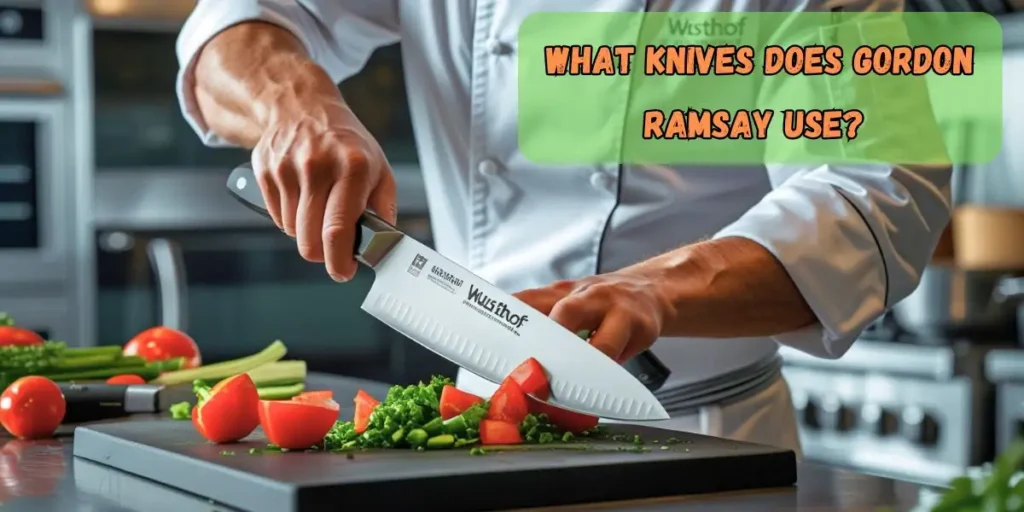 What knives does Gordon Ramsay use? Check out his premium knives
What knives does Gordon Ramsay use? Check out his premium knives -
 What Knife Do Navy Seals Use? SEAL's Standard Issue 2025
What Knife Do Navy Seals Use? SEAL's Standard Issue 2025 -
 What Knife Does John Wick Use? Learn About His Deadly Blade
What Knife Does John Wick Use? Learn About His Deadly Blade -
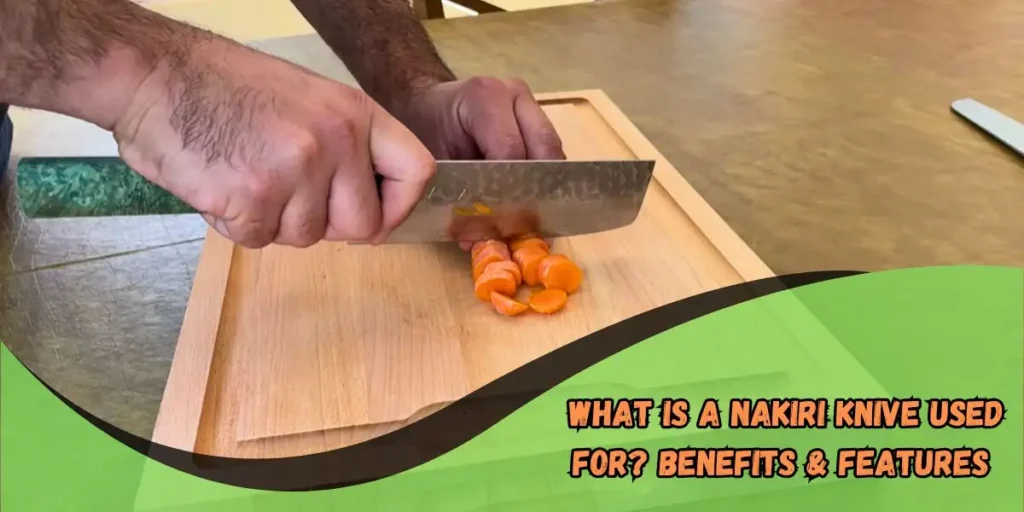 What is a Nakiri Knives Used For? Benefits & Features Explained
What is a Nakiri Knives Used For? Benefits & Features Explained -
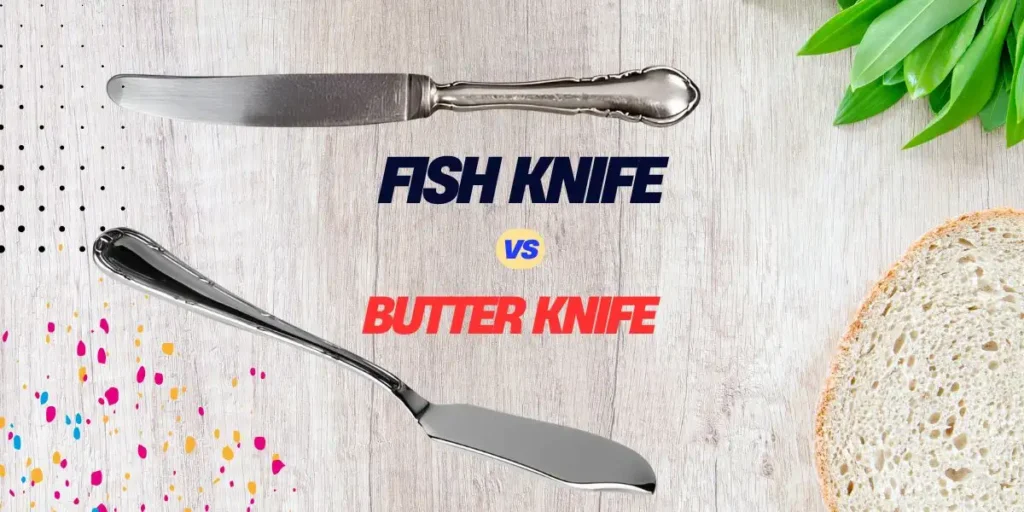 Fish Knife vs Butter Knife: Key Differences and Uses Explained
Fish Knife vs Butter Knife: Key Differences and Uses Explained -
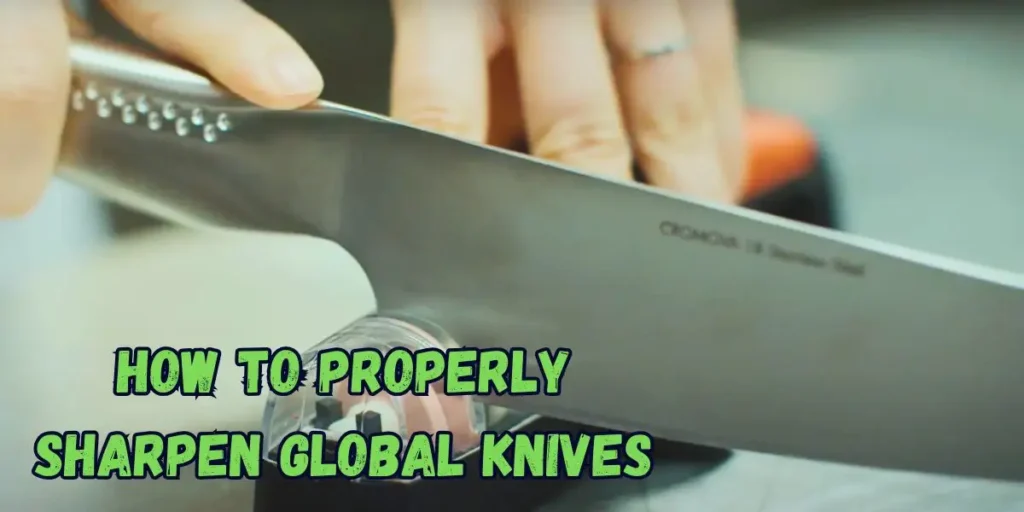 How to Sharpen Global Knife: A Quick Guide 2025
How to Sharpen Global Knife: A Quick Guide 2025 -
 Decoding the Iconic Why So Serious Joker Knife
Decoding the Iconic Why So Serious Joker Knife -
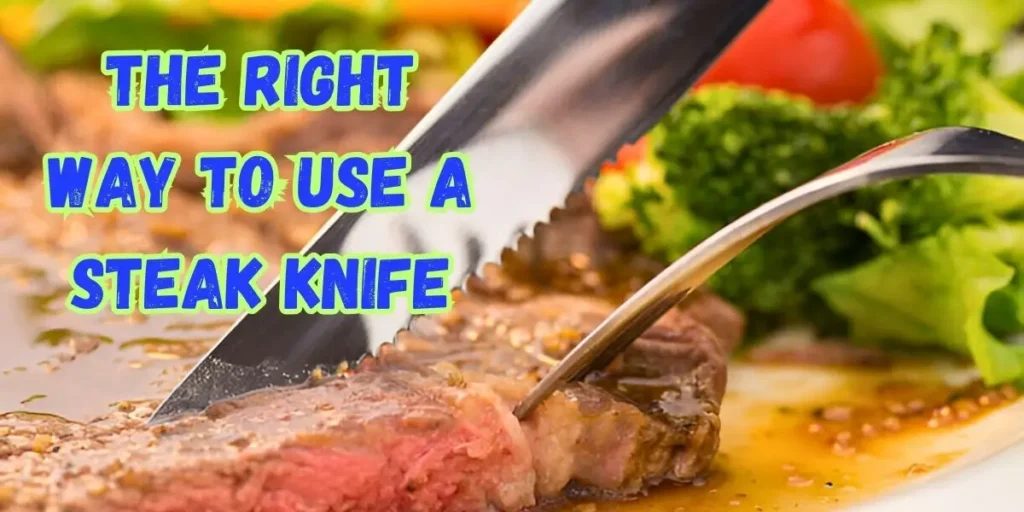 The Right Way to Use a Steak Knife: Tips and Tricks
The Right Way to Use a Steak Knife: Tips and Tricks -
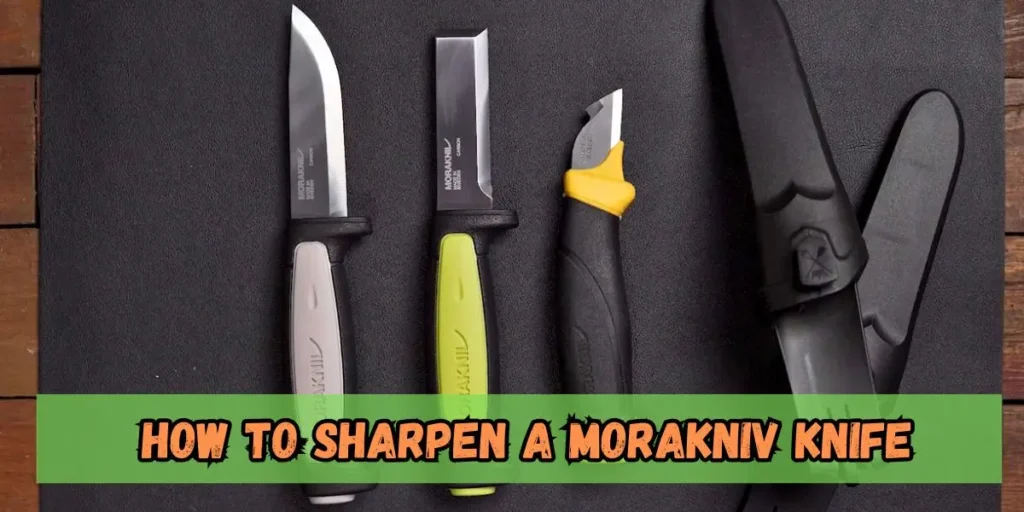 How to Sharpen a Morakniv Knife Safely and Effectively
How to Sharpen a Morakniv Knife Safely and Effectively

